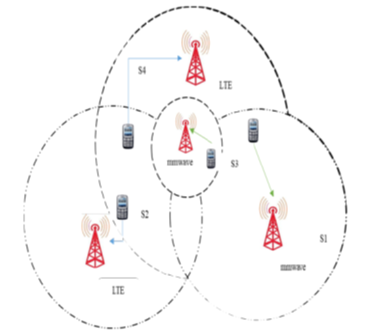


Indian Journal of Science and Technology
Year: 2022, Volume: 15, Issue: 25, Pages: 1244-1252
Original Article
G Nagaraja1*, H S Rameshbabu2, Gowrishankar3
1Associate Professor, Department of Information Science & Engineering, SJC Institute of Technology, Chickballapur - 562101, Karnataka, India
2Professor, Department of Computer Science and Engineering, Sai Vidya Institute of Technology Bangalore 560064, Bangalore - 560064, Karnataka, India
3Professor, Department of Computer Science & Engineering, BMS College Of Engineering, Bangalore – 560019, Karnataka, India
*Corresponding Author
Email: [email protected]
Received Date:06 April 2022, Accepted Date:29 April 2022, Published Date:11 July 2022
Objectives:To design an efficient resource allocation design for provisioning service of varied traffic classes to Multi-Mode Mobile Terminals (MMTs) in Heterogeneous Wireless Networks (HWNs). In HWNs, users prerequisite certain Quality of Service (QoS); thus, for meeting QoS, theMMTs are handoff to the new network. However, handoff MMTs might induce interference with the ongoing communication of existing MMTs. As resources are shared, resource allocation becomes a challenging task. Methods:This study presents a High-Efficiency Resource Allocation optimization model for HWNs. The HERA scheme first employs Channel State Information (CSI) estimation for mitigating interference and establishing channel availability. Second, using game theory optimal resource is allocated to MMTs and proves the existence of Nash equilibrium (NE) for spectrum resource allocation to MMTs in HWNs. Finally, a hybrid resource allocation algorithm combining contentionless and contention-based is designed to provide an improved resource allocation mechanism. Findings:The experiment outcome shows the HERA scheme allocates resources more efficiently in comparison with Access Fairness Resource Allocation (AFRA)(1), Joint Resource Allocation with Power Optimization (JRA-PO)(2), Resource Allocation and Node Placement (RANP)(3), and Existing Resource Allocation (ERA)(4). The HERA improves throughput by 19.07% and reduces collision by 42.96% in comparison with ERA(4) . Novelty: existing model predominantly focused on either addressing interference or maximizing throughput by leveraging either contention or contention-less resource allocation mechanism. However, in this study both contention-less and contention-based mechanisms are merged to maximize throughput and reduce collision.
Keywords: Interference; Quality of service; Resource allocation; Softcomputing; Spectrum utilization; Heterogeneous communication network
© 2022 Nagaraja et al. This is an open-access article distributed under the terms of the Creative Commons Attribution License, which permits unrestricted use, distribution, and reproduction in any medium, provided the original author and source are credited.
Published By Indian Society for Education and Environment (iSee)
Subscribe now for latest articles and news.